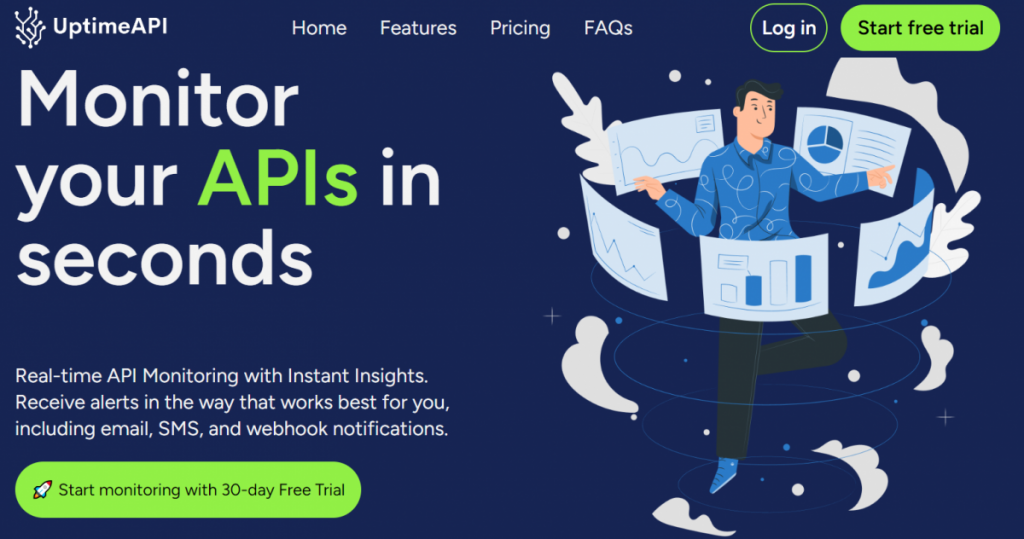In the dynamic realm of software development, ensuring the reliability and availability of APIs is paramount. The ability to promptly detect and respond to downtime is a crucial aspect of maintaining a positive user experience. UptimeAPI emerges as a key tool for developers, providing robust API downtime alerts that empower development teams to proactively address issues. In this article, we will explore the significance of API downtime alerts and delve into the detailed structure of an API response generated by UptimeAPI.
The Significance of API Downtime Alerts

1. Proactive Issue Resolution
API downtime can have a cascading effect on applications and services, leading to frustrated users and potential financial losses. Downtime alerts act as an early warning system, allowing developers to identify and address issues before they escalate. Proactive resolution minimizes service disruptions and ensures a consistent and reliable user experience.
2. User Experience Enhancement
Users today demand seamless and uninterrupted experiences from the applications they interact with. API downtime alerts enable developers to respond swiftly to incidents, reducing the impact on users and enhancing overall satisfaction. In the competitive landscape of software, a positive user experience is often the key differentiator.
3. Data-Driven Decision Making
Downtime alerts provide valuable data on the frequency and duration of disruptions. This data becomes a crucial resource for making informed decisions about infrastructure improvements, scaling strategies, and resource allocation. Developers can leverage these insights to optimize their systems for enhanced reliability.
UptimeAPI: Empowering Developers with Downtime Alerts

Read More: Company profile APIUsage Cases
1. Real-Time Monitoring for Instant Alerts
UptimeAPI excels in real-time monitoring, offering instant alerts when an API endpoint experiences downtime. Developers can configure alerting criteria based on specific parameters such as response time, error rate, and downtime duration. This ensures that the right people are notified promptly, allowing for quick and effective response.
2. Customizable Alerting for Tailored Notifications
Not all downtime incidents are created equal, and UptimeAPI acknowledges this by providing customizable alerting options. Developers can set thresholds that align with their application’s specific requirements. Whether it’s a minor blip or a critical issue, UptimeAPI allows for tailored notifications, preventing alert fatigue and ensuring focused attention on significant incidents.
3. Historical Downtime Analysis for Continuous Improvement
Understanding the historical performance of APIs is essential for identifying patterns and planning for future scalability. UptimeAPI offers comprehensive analytics tools, allowing developers to delve into historical downtime data. This historical context enables teams to identify recurring issues, track performance trends, and implement strategic improvements for long-term reliability.
API Response: Decoding UptimeAPI’s Language
When an API endpoint is monitored by UptimeAPI and downtime occurs, the API response provides insightful information for developers. Let’s break down what a typical API response from UptimeAPI might look like:
{
"status": "failure",
"timestamp": "2024-01-17T15:30:00Z",
"endpoint": "https://api.example.com",
"downtime_duration": 300,
"error_message": "Connection timeout"
}- status: Indicates the status of the API request to UptimeAPI. In this case, “failure” signifies downtime.
- timestamp: Provides the date and time of the API response.
- endpoint: Specifies the monitored API endpoint that experienced downtime.
- downtime_duration: Represents the duration of the downtime in seconds.
- error_message: Offers a brief description of the error that caused the downtime.
This detailed response equips developers with the information needed to diagnose and resolve the issue promptly.
Conclusion
API downtime alerts are the linchpin of a robust and reliable software ecosystem. UptimeAPI, with its powerful monitoring capabilities and customizable alerting features, emerges as a key ally for developers in ensuring the continuous availability of their APIs. By leveraging UptimeAPI’s downtime alerts, development teams can proactively address issues, enhance user experiences, and make informed decisions based on historical performance data.
In the ever-evolving landscape of software development, where downtime is not just an inconvenience but a potential threat, UptimeAPI stands as a beacon, providing developers with the tools they need to keep their APIs up and running at all times. Incorporate API downtime alerts into your development workflow, and empower your team to deliver reliable and resilient applications to users worldwide.

